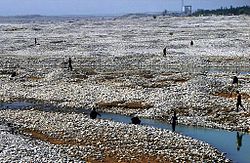| Yurungkash River White Jade River, Baiyu River | |
|---|---|
 Collecting jade in the White Jade River near Khotan in 2011 | |
 | |
| Native name | |
| Physical characteristics | |
| Source | Kunlun Mountains |
| • coordinates | 35°31′38″N81°29′42″E / 35.527297°N 81.495070°E |
| Mouth | Hotan River |
• coordinates | 38°04′53″N80°33′45″E / 38.081296°N 80.562477°E |
| Basin size | 14,575 km2 (5,627 sq mi) |
| Discharge | |
| • average | 72.3 cubic metres per second (2,550 cu ft/s) |
| Basin features | |
| Progression | Hotan→ Tarim→ Taitema Lake |
| White Jade River | |||||||||||
|---|---|---|---|---|---|---|---|---|---|---|---|
| Uyghur name | |||||||||||
| Uyghur | يورۇڭقاش دەرياسى | ||||||||||
| |||||||||||
| Chinese name | |||||||||||
| Traditional Chinese | 玉龍喀什 河 | ||||||||||
| Simplified Chinese | 玉龙喀什 河 | ||||||||||
| |||||||||||
| Alternative Chinese name | |||||||||||
| Chinese | 白玉河 | ||||||||||
| |||||||||||
The White Jade River is a river in southern Xinjiang,China. [1]
Contents
The head waters of the river rise in the Kunlun Mountains,in the area of Aksai Chin in Kashmir in the Togatax area ( 35°36′N81°24′E / 35.6°N 81.4°E ). The river flows east for some 200 km and then north for another 200 km before passing through Khotan,China ( 37°07′N79°58′E / 37.11°N 79.97°E ). [1] In Khotan,the river has yielded white river rocks which are also known as nephrite jade. [1] [2]
North of Khotan,it eventually dries up in the Taklamakan Desert,its seasonal bed joined by that of the Black Jade River (Karakash River) near Koxlax (some 200 km north of Khotan, 38°05′N80°34′E / 38.08°N 80.56°E ),from where it continues north as the Hotan River,which flows into the Tarim River. The river drains an area of 14,575 km2 (5,627 sq mi) and has a discharge of 72.3 cubic metres per second (2,550 cu ft/s).




